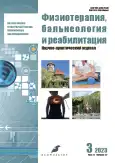Logistics of technologies in the framework of personalized rehabilitation of patients with chronic back pain
- Authors: Mitkovskiy S.V.1, Kiparisova E.S.1, Ekusheva E.V.1
-
Affiliations:
- Federal Scientific and Clinical Center of Specialized Types of Medical Care and Medical Technologies
- Issue: Vol 22, No 3 (2023)
- Pages: 151-159
- Section: Original studies
- Published: 08.12.2023
- URL: https://rjpbr.com/1681-3456/article/view/594216
- DOI: https://doi.org/10.17816/594216
- ID: 594216
Cite item
Abstract
BACKGROUND: Lower back pain covers a large part of the population and is common in all age groups. Scientific research shows not only significant medical and social, but also high economic costs associated with this problem.
AIM: optimization of diagnostic and rehabilitation approaches in the management of patients with chronic back pain.
MATERIALS AND METHODS: 126 patients participated in the ongoing single-center prospective cohort study. The assessment of neuroorthopedic examination and neuropsychological status, laboratory, neuroimaging (magnetic resonance tomography) and neurophysiological studies of patients, filling out scales and questionnaires, consultations of related specialists were carried out. 42 patients with a clinical picture of neuropathic pain underwent electromyography stimulation, and 16 of them underwent a transcranial magnetic stimulation study. Within the framework of the pilot project, 22 patients with identified undesirable side reactions when taking non-steroidal anti-inflammatory drugss underwent pharmacogenetic research and consulting by a medical geneticist to select personalized non-steroidal anti-inflammatory drugs pharmacotherapy. Based on the results of the examinations, taking into account the nature of the course of the disease and the prevailing pathogenetic variant of pain, an individual rehabilitation program was developed. To assess the individual rehabilitation program, the data obtained within each group were compared with the results of treatment of patients with the traditional approach (retrospective analysis of medical histories).
RESULTS: The study included 126 patients (67 men and 59 women) with lower back pain persisting for more than 3 months. The average age was 50.06±1.25 years. The average duration of the disease was 10±2.19 months. The patients were divided into 3 groups: the first group of 30 patients with back pain and the predominance of a dysfunctional component; the second group of 78 patients with neuropathic pain syndrome (radiculopathy); the third group included 18 patients with nociceptive variant of back pain. As a result of the pathogenetically directed rehabilitation program, it was possible to increase patients' adherence to treatment and compliance with recommendations (p <0.05) and reduce the need for surgical treatment in patients with discogenic radicular syndrome (p <0.05).
CONCLUSION: The multi-vector multidisciplinary approach with a pathogenetic focus on identifying and treating clinical and pathogenetic variants of pain and the causes of its persistence is the most effective, and physical rehabilitation methods are well combined with each other and with pharmacotherapy, potentiating each other's effects.
Full Text
About the authors
Sergey V. Mitkovskiy
Federal Scientific and Clinical Center of Specialized Types of Medical Care and Medical Technologies
Author for correspondence.
Email: mitkovskiy_sergey@mail.ru
ORCID iD: 0000-0002-3949-5448
Russian Federation, Moscow
Elena S. Kiparisova
Federal Scientific and Clinical Center of Specialized Types of Medical Care and Medical Technologies
Email: kiparisovaes@mail.ru
ORCID iD: 0000-0001-8956-3771
MD, Dr. Sci. (Medicine), Professor
Russian Federation, MoscowEugenia V. Ekusheva
Federal Scientific and Clinical Center of Specialized Types of Medical Care and Medical Technologies
Email: ekushevaev@mail.ru
ORCID iD: 0000-0002-3638-6094
MD, Dr. Sci. (Medicine), Professor
Russian Federation, MoscowReferences
- Walker BF. Prevalence of lower back pain: A systematic review of the literature from 1966 to 1998. J Spin Discord. 2000;13(3):205-217. doi: 10.1097/00002517-200006000-00003
- Yakhno NN, Kukushkin ML. Chronic pain: medico-biologic and sotsio-economic aspects. Annals Russ Acad Med Sci. 2012;67(9):54-58. EDN: PEVYZZ doi: 10.15690/vramn.v67i9.407
- Akhmadeeva LR, Rayanova GS. Acute non-specific low back pain as a medical and social problem. Modern Problems Sci Educat. 2016;(3):113. EDN: WXJAYB
- Breivik H, Collett B, Ventafridda V, et al. Survey of chronic pain in Europe: Prevalence, impact on daily life and treatment. Eur J Pain. 2006;10(4):287-333. doi: 10.1016/j.ejpain.2005.06.009
- Erdes SF, Dubinina TV, Galushko EA. Low back pain in general medical practice. Ther Arch. 2008;80(5):59-61. EDN: UAHKBL
- Titova NV. Patient with non-specific low back pain: DIagnostic and therapeutic algorithm. Russ Med Inquiry. 2016;24(12):775-781. EDN: WHKNNJ
- Cypress BK. Characteristics of physician visits for back symptoms: A national perspective. Am J Public Health. 1983;73(4):389-395. doi: 10.2105/ajph.73.4.389
Supplementary files






